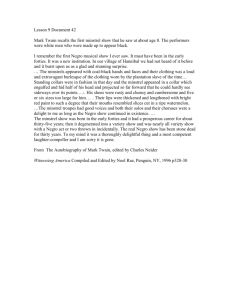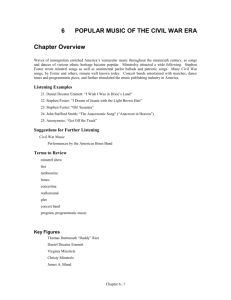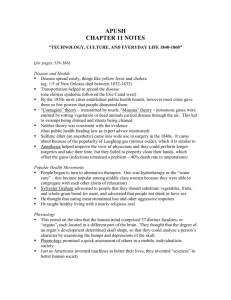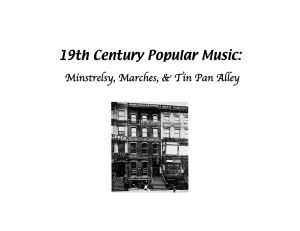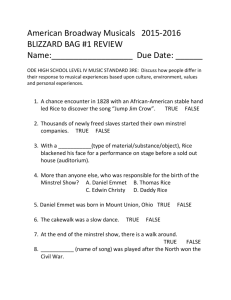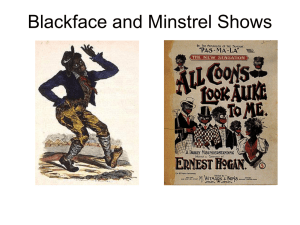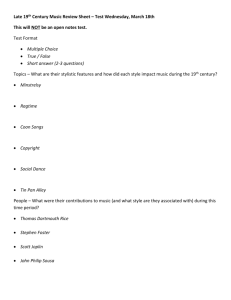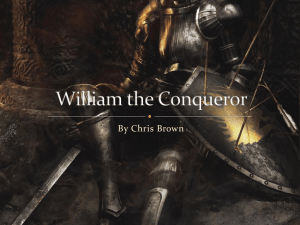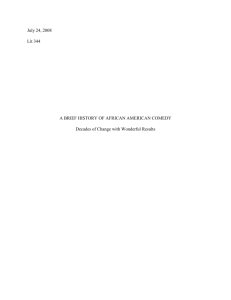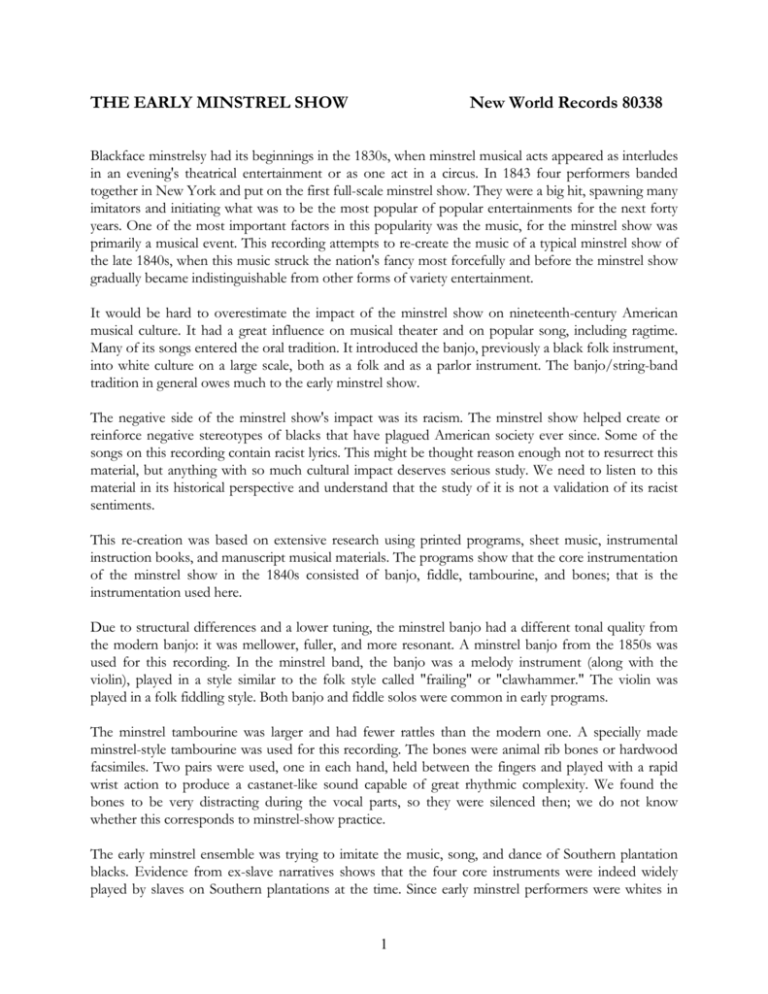
THE EARLY MINSTREL SHOW
New World Records 80338
Blackface minstrelsy had its beginnings in the 1830s, when minstrel musical acts appeared as interludes
in an evening's theatrical entertainment or as one act in a circus. In 1843 four performers banded
together in New York and put on the first full-scale minstrel show. They were a big hit, spawning many
imitators and initiating what was to be the most popular of popular entertainments for the next forty
years. One of the most important factors in this popularity was the music, for the minstrel show was
primarily a musical event. This recording attempts to re-create the music of a typical minstrel show of
the late 1840s, when this music struck the nation's fancy most forcefully and before the minstrel show
gradually became indistinguishable from other forms of variety entertainment.
It would be hard to overestimate the impact of the minstrel show on nineteenth-century American
musical culture. It had a great influence on musical theater and on popular song, including ragtime.
Many of its songs entered the oral tradition. It introduced the banjo, previously a black folk instrument,
into white culture on a large scale, both as a folk and as a parlor instrument. The banjo/string-band
tradition in general owes much to the early minstrel show.
The negative side of the minstrel show's impact was its racism. The minstrel show helped create or
reinforce negative stereotypes of blacks that have plagued American society ever since. Some of the
songs on this recording contain racist lyrics. This might be thought reason enough not to resurrect this
material, but anything with so much cultural impact deserves serious study. We need to listen to this
material in its historical perspective and understand that the study of it is not a validation of its racist
sentiments.
This re-creation was based on extensive research using printed programs, sheet music, instrumental
instruction books, and manuscript musical materials. The programs show that the core instrumentation
of the minstrel show in the 1840s consisted of banjo, fiddle, tambourine, and bones; that is the
instrumentation used here.
Due to structural differences and a lower tuning, the minstrel banjo had a different tonal quality from
the modern banjo: it was mellower, fuller, and more resonant. A minstrel banjo from the 1850s was
used for this recording. In the minstrel band, the banjo was a melody instrument (along with the
violin), played in a style similar to the folk style called "frailing" or "clawhammer." The violin was
played in a folk fiddling style. Both banjo and fiddle solos were common in early programs.
The minstrel tambourine was larger and had fewer rattles than the modern one. A specially made
minstrel-style tambourine was used for this recording. The bones were animal rib bones or hardwood
facsimiles. Two pairs were used, one in each hand, held between the fingers and played with a rapid
wrist action to produce a castanet-like sound capable of great rhythmic complexity. We found the
bones to be very distracting during the vocal parts, so they were silenced then; we do not know
whether this corresponds to minstrel-show practice.
The early minstrel ensemble was trying to imitate the music, song, and dance of Southern plantation
blacks. Evidence from ex-slave narratives shows that the four core instruments were indeed widely
played by slaves on Southern plantations at the time. Since early minstrel performers were whites in
1
blackface, the singers on this recording (who are white) are not attempting to sound like black
performers but rather like whites trying to imitate blacks. On the practical side, the heaviness of the
dialect is limited by the need to not sacrifice a basic clarity of enunciation. How much, if any, vibrato
was used in early minstrel singing is unknown, but our assumption is that there was little; our practice
follows this assumption, except in the operatic parody and in the most sentimental songs. We did not
strive for perfectly polished performances. The performance style of the early minstrel troupes ranged
from quite raucous to more refined.
The songs on this recording are among those that were the most frequently performed on the minstrel
stage between 1843 and 1852, as indicated by a study of a large number of playbills from that period.
They were chosen as particularly good representatives of the various types of popular minstrel songs.
All of these songs were printed in at least two different versions; we tried to pick the version that
seems to have been the most popular. The performances are intended to reflect the variety of ways
songs were presented in the early shows—accompanied or unaccompanied; solo voice throughout;
solo verse and four-part chorus; or four-part harmony throughout. The text and melody for each song
have come from the earliest sheet-music versions of the 1840s. The vocal harmonizations come either
from the sheet music or from Elias Howe's Ethiopian Glee Book (Boston, 1848). The instrumental
accompaniments are based on arrangements in early minstrel banjo and fife instruction books from the
1850s, and on a knowledge of American traditional banjo and fiddle music, out of which minstrel
music developed and which in turn was greatly influenced by minstrel music.
De Boatmen's Dance
(Boston, 1843). Credited to Dan Emmett; probably partly borrowed from oral tradition, where it is still
found. An example of a class of early minstrel comic songs dealing with the domestic or working life of
blacks.
Old Joe
(New York, 1844). Popular comic love song of the first minstrel decade.
The Fine Old Color'd Gentleman
(Boston, 1843). Unaccompanied glee (several stanzas omitted). Dan Emmett's parody of "The Fine
Old English Gentleman" is a typical minstrel parody song and is also representative of songs whose
comic stanzas are built around the oddities of a particular character.
Dr. Hekok Jig
Violin solo. Taken from Dan Emmett's manuscript tune book, where it is credited to Z. Bacchus.
Stop Dat Knocking
(New York, 1847). By A. F. Winnemore; William Clifton's arrangement. Unaccompanied; originally
may have been accompanied. Representative of the operatic parodies that became very popular in the
late 1840s.
Mary Blane
(New York, 1846). A sentimental courtship song by Billy Whitlock. Other versions end with the death
of Mary.
2
Instrumental Medley
The instrumental medley was the standard beginning for the minstrel show in this period; this one
includes "Old Johnny Boker," "Jim Along Josey," "Back Side of Albany," and "Old Zip Coon."
Miss Lucy Long
(New York, 1842). Comic love song by Billy Whitlock. The most popular song of the first minstrel
decade, eventually acquiring many sets of verses. Also found in oral tradition.
Old Uncle Ned
(Louisville, 1848). By Stephen Foster; unaccompanied. Represents the increasing importance of
sentimental songs in the second half of the first minstrel decade. Also found in oral tradition.
De Ole Jawbone
(Boston, 1840). Perhaps by Joel Sweeney. An example of a minstrel nonsense song with unconnected
comic verses, often using exaggeration or grotesquerie.
Pea Patch Jig
Banjo solo from Emmett's manuscripts, showing the kind of syncopation (precursor to ragtime) found
in some early minstrel banjo pieces.
Lucy Neal
(Boston, 1844). By J. P. Carter. Partly a comic love song, but also sentimental/tragic and ultimately
sympathetic to the slaves' plight.
Hard Times
(Boston, 1855). Popular banjo solo by Tom Briggs, from Briggs' Banjo Instructor.
—Robert B. Winans
Robert Winans is a professor of English and chair of Interdepartmental Studies at Gettysburg College, where he teaches
American literature and American folk courses, including African-American folk song and Anglo-American folk song.
SELECTED BIBLIOGRAPHY
Hamm, Charles. "‘Jim Crow’; or, The Music of the Early American Minstrel Show," in his Yesterdays:
Popular Music in America. New York: Norton, 1979.
Nathan, Hans. Dan Emmett and the Rise of Early Negro Minstrelsy. Norman: University of Oklahoma Press,
1962.
Paskman, Daily, and Sigmund Spaeth. "Gentlemen, Be Seated!": A Parade of the Old-Time Minstrels. New
York: Doubleday, Doran, 1928.
Toll, Robert C. Blacking Up: The Minstrel Show in Nineteenth-Century America. New York: Oxford
University Press, 1974.
Winans, Robert B. "Early Minstrel Show Music, 1843–1852," in Musical Theater in America: Papers and
Proceedings of the Conference on Musical Theater in America, ed. Glenn Loney, Westport, Conn.:
Greenwood, 1984, 71–97.
Wittke, Carl F. Tambo and Bones: A History of the American Minstrel Stage. Durham, N.C.: Duke University
Press, 1930.
3
SELECTED DISCOGRAPHY
Creole Belles: Music on the Mississippi from Stephen Foster to Scott Joplin. Chesapeake Minstrels. Hyperion
A66069.
The Old-Time Banjo in America. Various artists. Kicking Mule 204.
Music director and program consultant: Robert Winans
Recording engineer: James Spencer
Recorded at Solid Sound Recording Studio, Ann Arbor, Michigan, August 1980
Digital mastering: Dirk Sobotka, SoundByte Productions, Inc. NYC
Cover design: Bob Defrin Design, Inc., NYC
Cover picture: Copyright Deposit Collection, Music Division, Library of Congress
Library of Congress Card No. 85-743145
è 1985 © 1998 Recorded Anthology of American Music, Inc.
The original recordings were made possible with a grant from the Rockefeller Foundation.
This project is supported in part by a grant from the National Endowment for the Arts. This
recording was also made possible with a grant from Francis Goelet.
FOR NEW WORLD RECORDS:
Herman E. Krawitz, President; Paul Marotta, Managing Director; Paul M. Tai, Director of Artists
and Repertory; Lisa Kahlden, Director of Information Technology; Virginia Hayward,
Administrative Associate; Mojisola Oké, Bookkeeper; Ben Schmich, Production Associate.
RECORDED ANTHOLOGY OF AMERICAN MUSIC, INC., BOARD OF TRUSTEES:
David Hamilton, Treasurer; Milton Babbitt; Emanuel Gerard; Adolph Green; Rita Hauser; Herman E.
Krawitz; Arthur Moorhead; Elizabeth Ostrow; Don Roberts; Patrick Smith; Frank Stanton.
Francis Goelet (1926-1998), Chairman
è 1985 © 1998 Recorded Anthology of American Music, Inc. All rights reserved. Printed in USA.
THE EARLY MINSTREL SHOW
80338-2
1 DE BOATMEN'S DANCE (Dan Emmett)
2 OLD JOE
3 THE FINE OLD COLOR'D GENTLEMAN (Dan Emmett)
4 DR. HEKOK JIG (Z. Bacchus)
5 STOP DAT KNOCKING (A. F. Winnemore; William Clifton's arrangement)
6 MARY BLANE (Billy Whitlock)
7 INSTRUMENTAL MEDLEY
8 MISS LUCY LONG (Billy Whitlock)
9 OLD UNCLE NED (Stephen Foster)
10 DE OLE JAWBONE (Joel Sweeney?)
11 PEA PATCH JIG (Dan Emmett)
12 LUCY NEAL (J. P. Carter)
4
13 HARD TIMES (Tom Briggs)
(All selections are in the public domain)
Instrumentalists: Vincent Tufo, fiddle; Percy Danforth, bones; Matthew Heumann, tambourine;
Robert Winans, banjo (vocal on "Mary Blane")
Singers: David Van Veersbilck, tenor; Peter DiSante, lead; Brian Mark, baritone (lead on "Old Uncle
Ned"); Roger Smith, bass (featured on "Stop Dat Knocking")
NO PART OF THIS RECORDING MAY BE COPIED OR REPRODUCED WITHOUT
WRITTEN PERMISSION OF R.A.A.M., INC.
NEW WORLD RECORDS
16 Penn Plaza #835
NEW YORK, NY 10001-1820
TEL 212.290-1680 FAX 212.290-1685
Website: www.newworldrecords.org
email: info@newworldrecords.org
LINER NOTES Ó Recorded Anthology of American Music, Inc.
5


